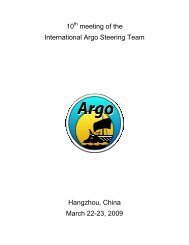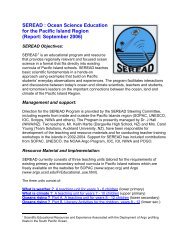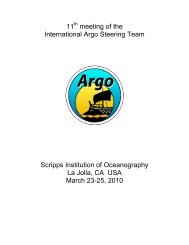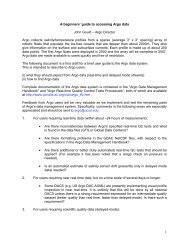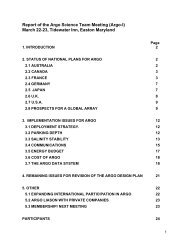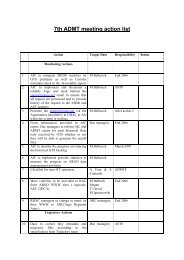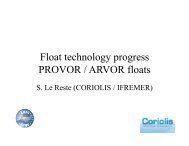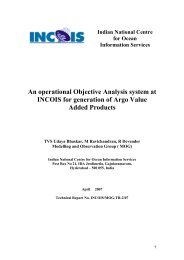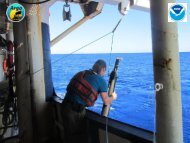AST-12 meeting report posted - Argo
AST-12 meeting report posted - Argo
AST-12 meeting report posted - Argo
Create successful ePaper yourself
Turn your PDF publications into a flip-book with our unique Google optimized e-Paper software.
closes on command. The board was designed by D. Swift and 100 units were built<br />
commercially in Seattle. This fix has been added to all UW and PMEL floats since February<br />
2011. Individual floats can be tested for this problem by connecting a laptop prior to deployment<br />
and inflating the bladder. Teledyne/Webb has been notified of this problem and the suggested<br />
remedy. As of March 2011, they have not instituted the remedy and they continue to build and<br />
ship floats with this potential problem. It is not clear whether or not they intend to add the<br />
auxiliary PCB in their production process.<br />
UW has developed a prototype float that uses a Kenwood PMT to communicate with ARGOS-3<br />
satellites. There were a couple of reasons for doing this. The first being that ARGOS-3 will<br />
someday provide bidirectional communications and could be a possible alternative to Iridium.<br />
The second being that the Seimac PTT used in Apex floats is no longer being manufactured so<br />
alternative communication methods for Apex ARGOS floats need to be explored. The first tests<br />
of the Kenwood PMT have shown that energy use is larger than with present ARGOS-2 PTTs.<br />
The PMT float has been running on a simulator at UW for several months and the PMT<br />
consumes more than twice the energy per transmission of the present ARGOS-2 Seimac PTT<br />
or Telonics PTT units.<br />
Finally, S. Riser presented on SeaBird CTD issues. SBE claims the microleak problem is now<br />
understood and fixed at the Druck factory. The glass/metal seals that caused the problem have<br />
been re-engineered and will be installed in SBE float CTDs beginning in July 2011. Until then,<br />
SBE is screening all Druck pressure sensors that are installed in float CTD units (possibly<br />
resulting in continued reduced production of CTD units). Some groups have tried the Kistler<br />
pressure sensors with good results so far in a limited number of floats for a limited time. SBE<br />
claims lab tests show the Kistler sensor to be as good or better than the new Druck sensors.<br />
Both Jamstec and PMEL have noted floats with unacceptable conductivity drift after deployment<br />
(> 0.01 PSU equivalent). This problem was traced to erosion of the platinum in the CTD<br />
electrodes. The cause of the problem has been found and new QC procedures have been<br />
installed at SBE. It is believed that this problem occurred in an isolated group of floats (CTDs<br />
built in late 2010) but all groups should check for this.<br />
Action item 26: S. Riser to draft a statement concerning solenoid problems on APEX<br />
floats to be <strong>posted</strong> on <strong>AST</strong> website and sent out on <strong>Argo</strong> email lists. S. Riser, M. Scanderbeg<br />
Action item 27: Ask SBE for serial numbers of CTDs having difficulty with conductivity<br />
sensor drift immediately after deployment and for serial numbers of CTDs with new, improved<br />
Druck sensor. S. Riser<br />
SOLO-II<br />
D. Roemmich updated everyone on the SOLO-II which is the newly redesigned SOLO float that<br />
is now commercially available through MRV Systems (http://www.mrvsys.com). The SOLO-II is<br />
engineered to complete around 300 dives anywhere in the world ocean using Iridium. It weighs<br />
less and is shorter than the SOLO making it easier to deploy.<br />
The first prototype SOLO-II was deployed in September 2009 and completed 20 three day<br />
cycles before being recovered. It was redeployed in February 2010 (WMO 490<strong>12</strong>42) and ran<br />
until its batteries were depleted in September 2010. During that time, it completed 324 deep<br />
cycles to 1750m with a 2 dbar sampling scheme on the rise all the way up to 3 dbar when the<br />
pump was turned off. The rise rate was around 13 cm/s. The second SOLO-II prototype had a<br />
new antenna and a redesigned bottom hemisphere and bladder. This one was deployed in<br />
23



